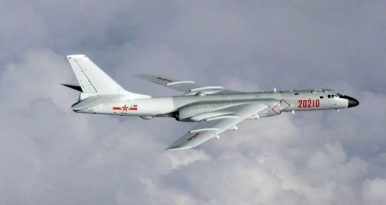By Franz-Stefan Gady
Yesterday for the first time, the Chinese People’s Liberation Army Air Force (PLAAF) and the Russian Air Force jointly conducted a long-range aerial patrol involving two Chinese Xian H-6K and two Tupolev Tu-95MS long-range, nuclear-capable bombers in the Indo-Pacific region. According to the Russian Ministry of Defense (MoD), the aim of the mission was to “strengthen global stability” and points to one of three reasons why the joint strategic bomber patrol flights are geopolitically important.
First, the flights, at one level, were intended to send a signal to the United States and its allies that the two powers are moving toward a political convergence, albeit no direct military cooperation, on certain nuclear issues in the face of a more assertive U.S. nuclear weapons policy and the slow unraveling of arms limitations agreements. A month earlier, in a joint statement, Chinese President Xi Jinping and his Russian counterpart, Vladimir Putin, emphasized “that any attempts to destroy the existing system of agreements on arms control, disarmament and non-proliferation are unacceptable.”
Nuclear weapons might also point to why the two air forces have chosen to conduct their patrol in close vicinity to the Korean Peninsula. China and Russia have repeatedly expressed their concerns over the deployment of Terminal High Altitude Area Defense (THAAD) systems that include long-range radars, by the United States on the Korean Peninsula. Beijing and Moscow have called the deployment “reckless” and likely to destroy “the strategic balance” in the region. China especially has expressed its concerns over the THAAD deployment as it may threaten the country’s second-strike capability. The flight of four Chinese and Russian nuclear-capable bombers off the Korean Peninsula forcefully underscores the indignation of the two countries with the status-quo when it comes to U.S. missile defense systems in the region.
Additionally, U.S. President Donald Trump has expressed his interest in pursuing a new nuclear arms control treaty that would not only cap the nuclear arsenals of the U.S. and Russia, but also China, which has a no-first use policy. While China has shown no interest in negotiating such a treaty, deeper China-Russia cooperation on nuclear issues could still strengthen both countries’ position in any future arms limitations negotiations vis-à-vis the United States. A united Sino-Russian front could also make it much more difficult to extract any concessions on land-based intermediate-range ballistic and cruise missiles from either countries in the future, although the likelihood of any serious negotiations is slim to non-existing at the present in any case.
Notably, the nuclear dimension is also what makes yesterday’s aerial patrol different from past joint Sino-Russian naval exercises that so far have not included any ballistic missile submarines.
Second, the patrols underline a new level of Sino-Russian technical cooperation in the air and underscore the growing military capabilities of the two powers. While the Sino-Russian bomber mission does not require NATO-type operability, it nonetheless points to potential deeper cooperation in the future. The aim of the patrol was “upgrading joint operation capacity,” according to a Chinese defense ministry spokesperson. As the defense analyst Dmitry Stefanovich has pointed out, should the two air forces achieve a level of interoperability that would permit the development of a joint air refueling capability, its impact on the regional strategic balance could be significant.
Third, the broader point of the Sino-Russian bomber mission is to underscore the growing military ties between the two countries. China’s new national defense white paper states that “the military relationship between China and Russia continues to develop at a high level, enriching the China-Russia comprehensive strategic partnership of coordination for a new era and playing a significant role in maintaining global strategic stability.” Of particular interest in that regard is that Chinese ground forces have for the first time participated at the brigade level in a large-scale Russian military exercise last year.
According to a Russian government decree issued earlier this week, the two countries are currently negotiating a new military cooperation agreement. Interestingly, press statements about the bomber patrol flights by both the Chinese and Russian defense ministries refer to a Russian-Chinese “military cooperation plan for 2019.” It is unclear what this signifies to as no such plan has been made public to date and its exact provisions remain unknown. However, its mere existence signifies a hitherto unknown level of cooperation.
However, despite their growing military partnership the two countries are still not allies. China wants “partnerships, not alliances,” a defense ministry spokesperson emphasized yesterday. China and Russia are not committed to collective defense and do not have a formal security pact that commits them to defend one another in the event of war. They also still each other as a security threat, albeit a remote one.
Sino-Russian military ties will not culminate in a bilateral equivalent of a permanent and highly interoperable military alliance like NATO. Rather, China and Russia are more likely to develop a 19th century type of military alliance like the Entente Cordiale, where both sides remain largely independent actors without a joint command structure, ad-hoc operational coordination, but an overall joint war-fighting strategy.

No comments:
Post a Comment